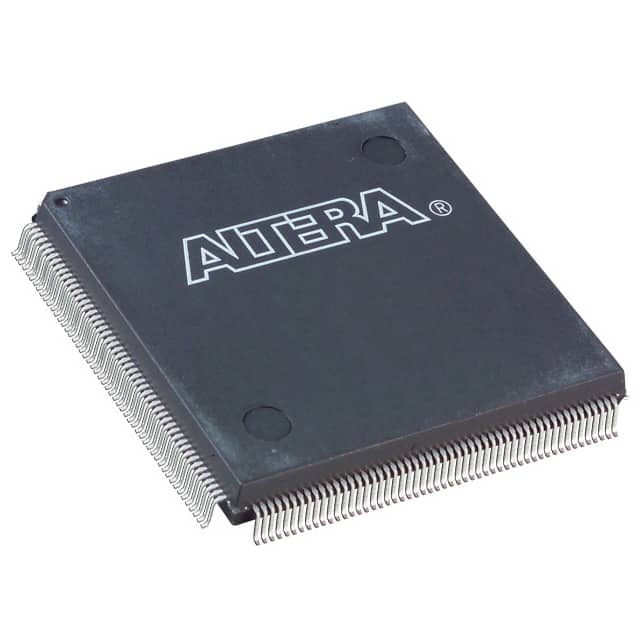Xem thông số kỹ thuật để biết chi tiết sản phẩm.

EPF10K30AQC208-3N
Product Overview
Category: Programmable Logic Device (PLD)
Use: The EPF10K30AQC208-3N is a PLD designed for digital logic applications. It provides flexible and customizable logic functions, making it suitable for a wide range of electronic systems.
Characteristics: - High-performance programmable logic device - Advanced architecture for efficient logic implementation - Low power consumption - Fast operation speed - Large number of input/output pins - Flexible programming options
Package: The EPF10K30AQC208-3N comes in a Quad Flat Pack (QFP) package, which ensures easy integration into circuit boards. The package dimensions are 20mm x 20mm.
Essence: The essence of the EPF10K30AQC208-3N lies in its ability to provide designers with a versatile and efficient solution for implementing complex digital logic functions.
Packaging/Quantity: The EPF10K30AQC208-3N is typically packaged in reels or trays, depending on the manufacturer's specifications. The quantity per package varies, but it is commonly available in quantities of 100 or more.
Specifications
- Logic Elements: 30,000
- Number of I/O Pins: 208
- Operating Voltage: 3.3V
- Operating Temperature: -40°C to +85°C
- Programming Technology: In-system programmable (ISP)
- Package Type: QFP
- Package Dimensions: 20mm x 20mm
Pin Configuration
The EPF10K30AQC208-3N has a total of 208 pins, each serving a specific purpose in the device's functionality. The detailed pin configuration can be found in the device's datasheet.
Functional Features
- Flexible Logic Implementation: The EPF10K30AQC208-3N offers a wide range of logic elements, allowing designers to implement complex digital functions efficiently.
- In-system Programmability: The device can be programmed while in operation, enabling on-the-fly updates and modifications to the logic functions.
- High-Speed Operation: With its advanced architecture, the EPF10K30AQC208-3N delivers fast operation speeds, making it suitable for applications that require real-time processing.
- Low Power Consumption: The PLD is designed to minimize power consumption, ensuring energy-efficient operation.
Advantages and Disadvantages
Advantages: - Versatile and customizable logic implementation - In-system programmability allows for flexibility and updates - High-speed operation for real-time applications - Low power consumption for energy efficiency
Disadvantages: - Limited number of logic elements compared to higher-end PLDs - Relatively small package size may limit the complexity of designs
Working Principles
The EPF10K30AQC208-3N operates based on the principles of programmable logic. It consists of configurable logic blocks (CLBs), input/output blocks (IOBs), and interconnect resources. These components work together to implement the desired logic functions specified by the designer. The device can be programmed using hardware description languages (HDLs) or design software provided by the manufacturer.
Application Field Plans
The EPF10K30AQC208-3N finds applications in various fields, including: 1. Industrial automation 2. Telecommunications 3. Automotive electronics 4. Consumer electronics 5. Medical devices
In industrial automation, the PLD can be used for control systems, motor drives, and process monitoring. In telecommunications, it can be utilized for network switches, routers, and signal processing. Automotive electronics benefit from the PLD's ability to implement complex control systems and driver assistance features. In consumer electronics, it can be employed in gaming consoles, multimedia devices, and home automation systems. Medical devices can utilize the PLD for data acquisition, signal processing, and control functions.
Alternative Models
- EPF10K50SQC240-2N
- EPF10K100ABC356-3
- EPF10K200SFC484-1
- EPF10K400CB672-3
- EPF10K500ABC600-2
These alternative models offer varying logic capacities, package types, and pin configurations, providing designers with options that suit their specific requirements.
Note: The content provided above is a sample entry and may not reflect actual specifications or details of the EPF10K30AQC208-3N or its alternative models.
Liệt kê 10 câu hỏi và câu trả lời thường gặp liên quan đến ứng dụng EPF10K30AQC208-3N trong giải pháp kỹ thuật
Sure! Here are 10 common questions and answers related to the application of EPF10K30AQC208-3N in technical solutions:
Q: What is EPF10K30AQC208-3N? A: EPF10K30AQC208-3N is a programmable logic device (PLD) manufactured by Intel (formerly Altera). It is part of the MAX® 7000 series and has 10,000 usable gates.
Q: What are the typical applications of EPF10K30AQC208-3N? A: EPF10K30AQC208-3N is commonly used in various digital design applications such as industrial control systems, telecommunications equipment, automotive electronics, and consumer electronics.
Q: What are the key features of EPF10K30AQC208-3N? A: Some key features of EPF10K30AQC208-3N include 10,000 usable gates, 208-pin QFP package, 3.3V operation, 5V tolerant I/Os, and on-chip memory blocks.
Q: How can EPF10K30AQC208-3N be programmed? A: EPF10K30AQC208-3N can be programmed using the Quartus® II software provided by Intel. The programming file can be loaded onto the device using a programmer or through in-system programming (ISP).
Q: Can EPF10K30AQC208-3N be reprogrammed? A: Yes, EPF10K30AQC208-3N is a reprogrammable device. It can be erased and reprogrammed multiple times, allowing for flexibility in design iterations.
Q: What is the maximum operating frequency of EPF10K30AQC208-3N? A: The maximum operating frequency of EPF10K30AQC208-3N depends on the complexity of the design and the specific implementation. It can typically operate at frequencies up to several tens of megahertz.
Q: Can EPF10K30AQC208-3N interface with other components or devices? A: Yes, EPF10K30AQC208-3N can interface with other components or devices through its I/O pins. It supports various standard interfaces such as GPIO, SPI, I2C, UART, and more.
Q: What are the power supply requirements for EPF10K30AQC208-3N? A: EPF10K30AQC208-3N operates at a 3.3V power supply voltage. It also has 5V tolerant I/Os, allowing it to interface with devices operating at 5V logic levels.
Q: Are there any development boards available for EPF10K30AQC208-3N? A: Yes, Intel provides development boards like the MAX® II Development Kit that can be used for prototyping and testing designs using EPF10K30AQC208-3N.
Q: Where can I find more information about EPF10K30AQC208-3N? A: You can find more detailed information about EPF10K30AQC208-3N in the datasheet provided by Intel. Additionally, online resources such as application notes and user guides are available on Intel's website.

